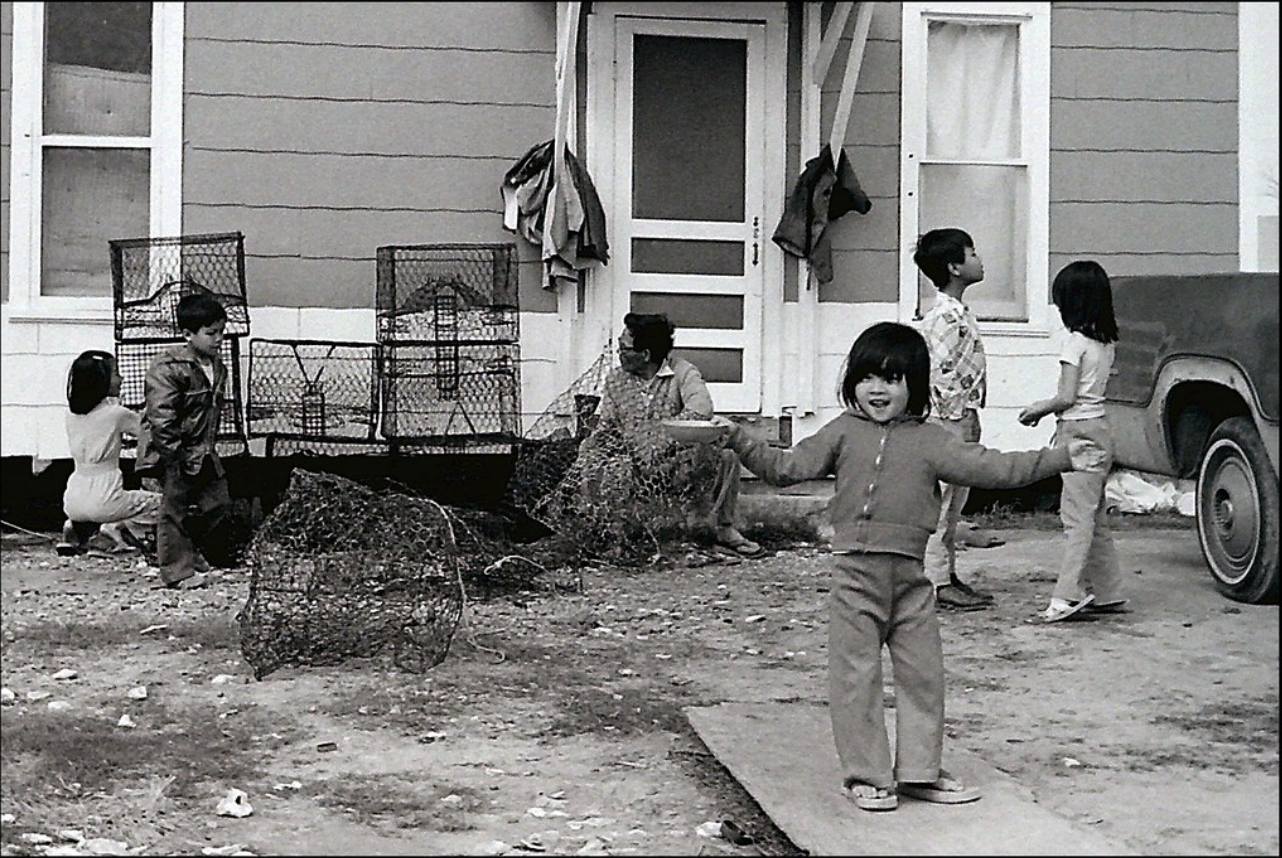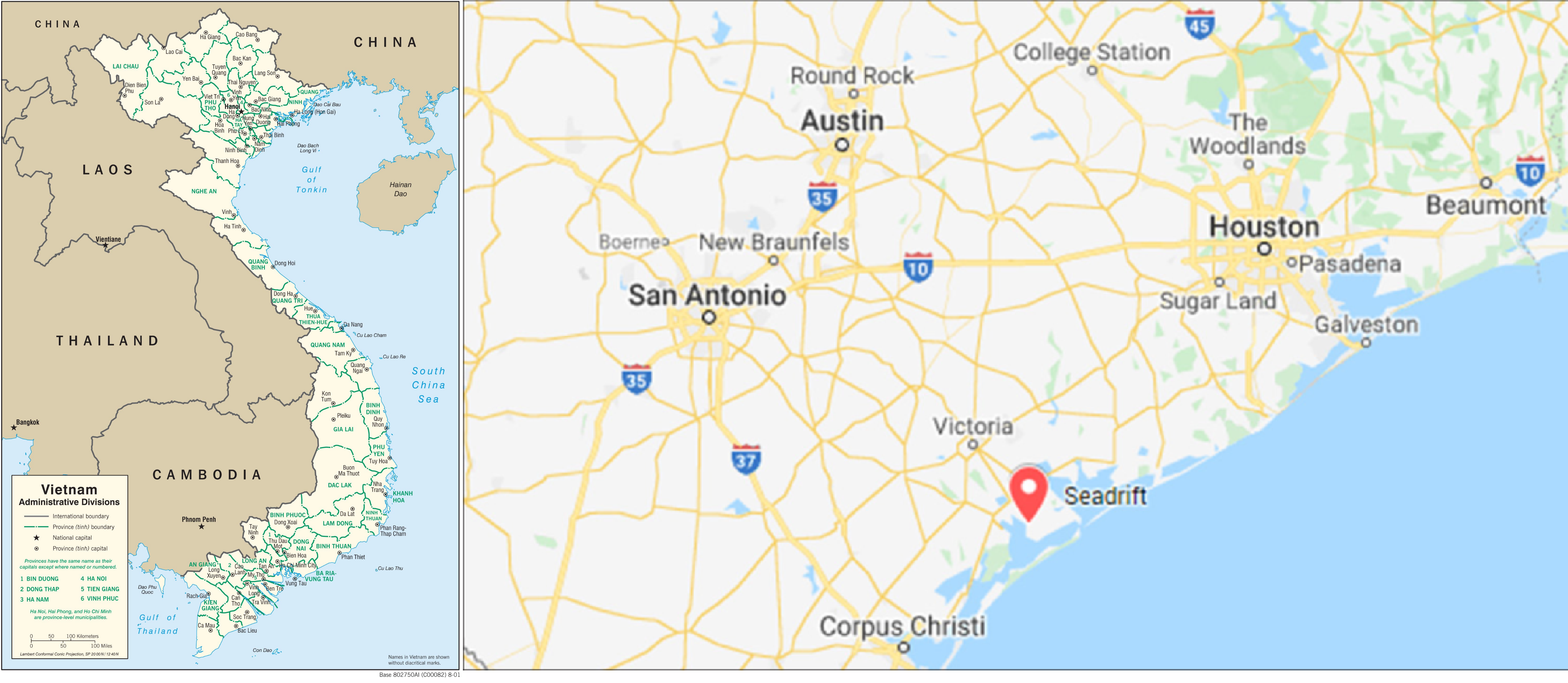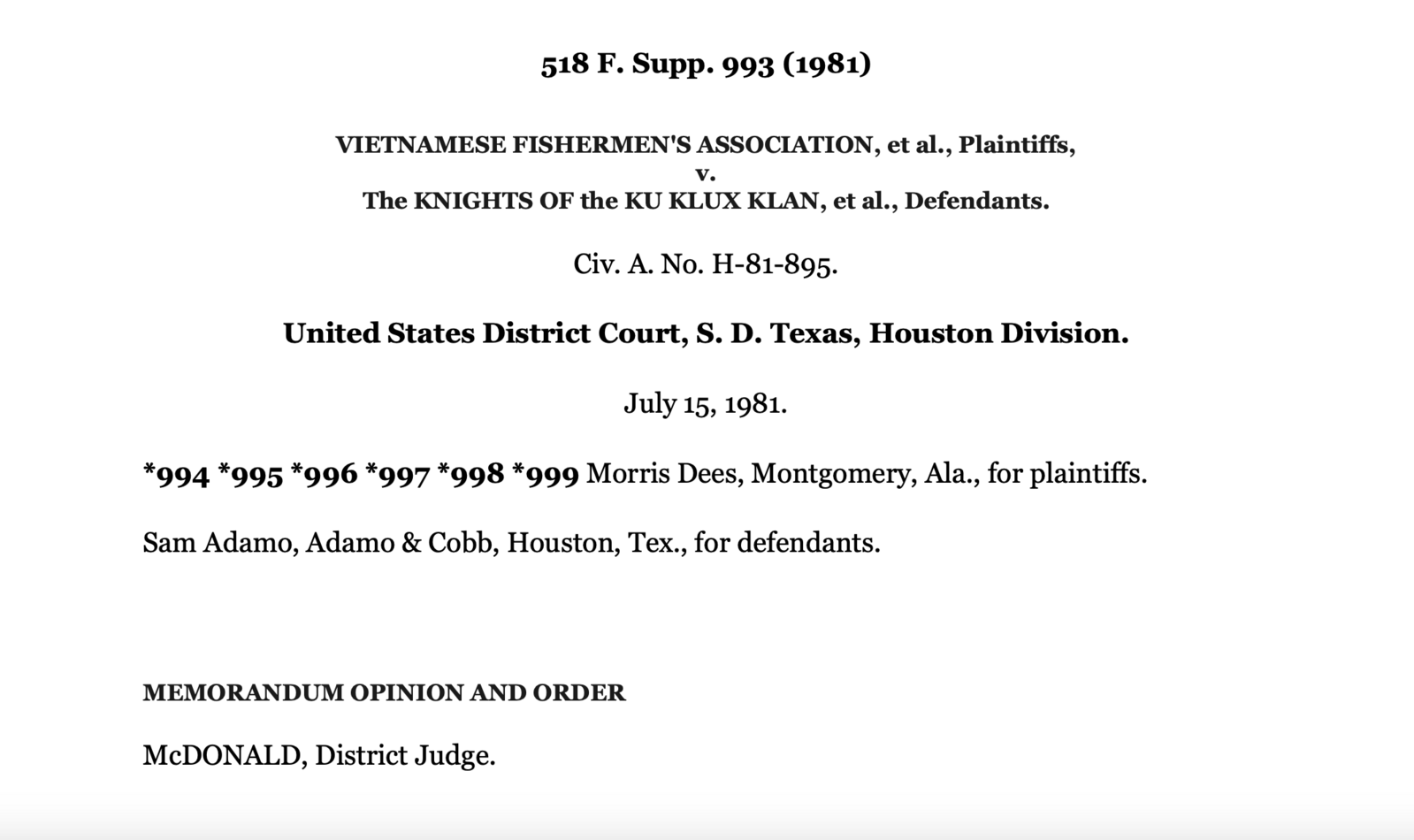4.6.5 - Vietnamese Fishermen’s Association v. Knights of the Ku Klux Klan
The Asian American Education Project
All content is owned by The Asian American Education Project (AAEdu). As such, users agree to attribute all work to The Asian American Education Project.
Title 8 Productions.
Grade: 9-12Subject:
English Language Arts, Social Studies, U.S. History
Number of Activities: 4
After the Vietnam War (1955-1975), many Vietnamese refugees who worked as shrimpers and fishermen in rural Vietnam settled in the Gulf Coast in Texas. Tensions erupted between white fishermen and Vietnamese fishermen. In this lesson, students will learn about the causes and effects of the Vietnamese Fishermen’s Association v. Knights of the Ku Klux Klan (1981), a court case that struck down the Ku Klux Klan’s intimidation campaign against recently resettled Vietnamese refugees on the Gulf Coast in Texas.
Students will:
- Describe the causes and effects of the Vietnamese Fishermen's Association v. Knights of the Ku Klux Klan (1981)
- Evaluate the causes of tensions against the Vietnamese
- Examine the legacy of Vietnamese refugees on the Texas community
Vietnamese Fishermen's Association v. Knights of the Ku Klux Klan Essay
The First
Indochina War between France and North Vietnam ended with the 1954 Geneva Accords, a treaty that ended French colonialism and established Vietnam as an independent nation. Vietnam was divided into two states: a Northern communist state and a Southern non-communist state. These Accords also promised an election in 1956 that would reunite Vietnam. Instead, the North Vietnamese started warring with the South, resulting in civil war.
The U.S. government believed that communism was a threat to democracy and subsequently supported South Vietnamese forces; this included sending U.S. troops to fight against the North Vietnamese. On April 30, 1975, the communist government took over South Vietnam and united the country into the Socialist Republic of Vietnam. This was known as the Fall of Saigon and marked the end of the Vietnam War.
South Vietnamese supporters and allies scrambled to evacuate themselves and their families out of the country. In 1975, nearly 130,000 Vietnamese, Cambodian, Laotian, and Hmong people
resettled as
refugees in the United States. The first wave of refugees often had ties to the U.S. military and were more educated and affluent compared to subsequent waves. The second and third wave refugees, known as “boat people,” were typically less educated than the first wave. This included shrimpers and fishermen from rural Vietnam, who were attracted to the Gulf Coast in Texas and Louisiana because they could transfer the fishing skills they had learned from Vietnam. Fishing was a desirable job because it didn’t require the refugees to speak English.
Seadrift is a small town on the Texas Gulf Coast. It was a popular site for some of the resettled Vietnamese refugees. After arriving in Seadrift, the Vietnamese community banded together and lived in crowded trailers. They worked together, hauling large catches back to shore and even crabbing during
inclement weather. To purchase the necessary materials to successfully fish, the Vietnamese developed a private loan system known as “hui.” They pooled their money, which was then distributed to a different family every month. This collective system helped each family survive.
Unbeknownst to the Vietnamese who moved into Seadrift, the mostly White fishermen who resided there were already struggling. The water was poisoned from pollution caused by dumping from nearby
petrochemical plants and oil spills. Despite seeing deformed fish and shrimp before the refugees came, the White community blamed the resettled Vietnamese population. They accused the newly arrived Vietnamese of overfishing, of breaking unwritten rules that they had often broken themselves, and of generally destroying Seadrift’s way of life. Tensions escalated as White fishermen started confronting the Vietnamese fishermen, disrupting their fishing and threatening violence.
Despite the interventions of local and federal officials, the strains between the two communities culminated in an explosion of violence. On August 3, 1979, a White fisherman named Billy Joe Aplin, who had previously threatened and harassed the Vietnamese, yelled at Sáu Văn Nguyễn, a young Vietnamese crabber, and his brothers. Aplin struck Sáu and cut his chest with a knife. Sáu left one of his brothers in a boat and drove off with his other brother to retrieve his gun. Sáu then rushed back to the docks and engaged Aplin. Eventually, Sáu fatally shot Aplin and fled Seadrift.
That night, White townspeople
firebombed three Vietnamese boats and an apartment rented by a
multi-generational Vietnamese family. Other Vietnamese families received threatening phone calls. In the next two days, 120 of the 150 Vietnamese refugees fled Seadrift. Those who stayed rearranged their trailers into a
compound so that they could guard each other more easily.
To further scare Vietnamese fishermen, some White fishermen in the area called in the Ku Klux Klan, a White supremacist hate group. This escalated a campaign of racial intimidation against the resettled Vietnamese.
In 1979, Sáu was tried for the murder of Aplin and then was
acquitted by an all-White jury who ruled he was defending himself. The Ku Klux Klan inflamed the situation. Louis Beam, the Grand Dragon or leader of the Texas Klan, proclaimed, “Where ballots fail, bullets will prevail.” Over the next year, the Ku Klux Klan held rallies, burned crosses, burned a boat, and even hung an
effigy of a Vietnamese fisherman. They patrolled the harbor with firearms and faces unmasked, knowing that the general public supported the intimidation of the Vietnamese fishermen. Beam also activated the Texas Emergency Reserve, an armed and trained
militia in Texas, openly declaring his intentions to inflict violence on the Vietnamese community. Despite the Vietnamese community’s attempts to make peace with the White community, including
concessions on fishing and trying to stop additional resettlement by Vietnamese to the area, the Ku Klux Klan pressed on.
In 1981, the Vietnamese Fishermen's Association, supported by the Southern Poverty Law Center, successfully ended Klan intimidation through a lawsuit in
Vietnamese Fishermen's Association v. Knights of the Ku Klux Klan (1981). The Ku Klux Klan and their allies were forbidden from intimidating the Vietnamese community. The Vietnamese prevailed; they could now fish without harassment or intimidation. A year later, that same judge
dismantled the KKK’s
paramilitary militia across the whole state.
Today, the Vietnamese fishermen are still fighting – but this time alongside White fishermen. Together, they are confronting corporations that have dumped harmful chemicals into the Gulf Coast. In 1993, hundreds of Vietnamese organized against pollution in the water. In 2019, one of their allies, Diane Wilson, the first woman shrimper in the area, won a $50 million settlement with Formosa Plastics. In collaboration with the Vietnamese and White fisherman, she is deciding how to redistribute the money to help the community. By working together instead of competing against each other, the fishermen are getting higher prices for their catches. Today, a coalition of Vietnamese Americans work internationally with communities in Vietnam and Taiwan and locally with other Gulf Coast communities to seek justice from Formosa Plastics.
Bibliography:
Johnson, Kirk Wallace. (2022). The Fisherman and the Dragon: Fear, Greed, and a Fight for Justice on the Gulf Coast. Viking.
Seadrift. (2020). Directed by Tim Tsai. Title 8 Productions.
- Acquit: to discharge someone from an accusation
- Compound: a fenced or walled-in collection of residences
- Concession: the act of acknowledging something, even hesitantly
- Dismantle: to destroy or break down the pieces of something
- Effigy: a representation of a hated person
- Firebomb: to use an incendiary bomb
- Inclement: severe or bad
- Indochina War: the 1946 - 1954 war between France and Vietnam against colonialism
- Militia: a group of armed private citizens
- Multi-generational: more than one generation
- Overture: an initiative toward agreement or compromise
- Paramilitary militia: an unauthorized, armed group of civilians
- Petrochemical: chemicals from petroleum or natural gas
- Refugee: someone that flees to another country or place due to danger or persecution
- Resettle: to settle in a new place to live
- What parties/groups were involved in the Vietnam War? What were their goals?
- Why did Vietnamese refugees resettle in Seadrift, Texas?
- How and why did the population of Seadrift, Texas change?
- Why were there tensions between the Vietnamese and White shrimpers? How did these tensions manifest?
- What role did the Ku Klux Klan play?
- How did the Vietnamese community resist some of the racial tensions?
- What is the legacy of Vietnamese fishermen in the Texas community?
- How and why did the Vietnamese refugees in Seadrift collaborate with each other?
- How and why did the Vietnamese refugees in Seadrift collaborate with other White fisherman?
Left - Map of Vietnam.
Credit: The Central Intelligence Agency (CIA), Public Domain
Right - Map of Seadrift, Texas.
Credit: Vicinity Map Seadrift, TX. Map data ©2021 INEGI, Google.
CC BY 4.0
Activity 1: Learning about Vietnamese Fishermen's Association v. Knights of the Ku Klux Klan (1981)
-
Ask students what they know about the Vietnam War. If needed, teach The Asian American Education Project’s lesson entitled, “Southeast Asian Refugees.”
- Show students a map of Vietnam and a map of Seadrift, Texas. Have students compare and contrast the two areas.
- Have students watch the video entitled, “Vietnamese Fishermen vs. the KKK | AAPI Moments.” Have students discuss what they learned from the video.
- Have students read the essay. Consider the following options:
- OPTION 1: Have students read the essay independently either for homework or during class time.
- OPTION 2: Read aloud the essay and model annotating.
- OPTION 3: Have students read aloud in pairs or small groups.
- Facilitate a discussion by asking the Discussion Questions.
The case of Vietnamese Fishermen’s Association v. The Knights of the Ku Klux Klan.
Credit: “Vietnamese Fishermans Association V Knight of Ku Klux Klan” by US District Court for the Southern District of Texas - 518 F. Supp. 993 (S.D. Tex. 1981),
CC BY-SA 4.0, via Wikimedia Commons
Activity 2: Evaluate the Causes of Tensions
- Jigsaw students into small groups and assign each group to read the following texts:
- Group 1: "Killing Sharpens Texas Feud on Vietnamese Fishing" (1979 New York Times article) and the Seadrift: A Documentary on Refugees, Racism, and Reconciliation trailer
- Group 2: "Fishing Town in Texas Tells the Klan to Stay Away" (1979 New York Times article) and Klan rally against Vietnamese fishermen in Texas (1981)
- Group 3: 1979 - 1981 Special Report: Vietnamese vs. Ku Klux Klan (video) and the Southern Poverty Law Center’s case overview of Vietnamese Fishermen’s Association vs. Knights of the Ku Klux Klan (1981)
- Have students critically review their group’s assigned text by completing the “Critical Reading worksheet.” Have students consider the different biases present in the text in order to critically analyze the causes and effects of the tensions between the Vietnamese and White shrimpers.
- Facilitate a discussion by reviewing student responses to the worksheet. Remind students to be aware of the biases present in each of the articles.
- Have students identify the main tensions between the White shrimpers and the Vietnamese refugees. Write them on the board.
- Have students analyze the causes of the tensions between the Vietnamese and White communities on the Gulf Coast by completing the following activities:
- List all of the causes of the tension by writing each cause on a sticky note and posting next to the tension. For each stated cause, ask students: What specific evidence from the sources made you think this caused tension between Vietnamese and White shrimpers?
- Group each cause into the following categories: economic, political, cultural, ideas and beliefs, and environmental. (If needed, explain each of these concepts.) Have students justify their categorizations. (Allow students the opportunity to create and justify additional categories.)
- Have students identify the top 2-3 causes of the tensions by using the new groupings to rank which cause most led to interracial tensions.
- Facilitate a whole class discussion by asking the following question: What factors most contributed to the tensions between the White and Vietnamese communities? Encourage students to cite textual evidence in their reasoning.

A Vietnamese Fisherman's Family in Seadrift, Texas, 1978.
Activity 3: Examining the Legacy of the Vietnamese on the Texas community

“The Gulf Fisheries, Galveston, Texas” ca. 1913
Activity 4: Correcting the Historical Record
- Ask students to listen to and read the lyrics to Bruce Springsteen’s song “Galveston Bay.”
- Have students do a close reading of the lyrics by making connections to the texts they had critically read in Activity 2. They can annotate using the following code:
- * = accurate information
- X = inaccurate information
- ? = I’m unsure if this is accurate or not
- Have students review the lines they annotated with question marks. Have them make a list of information that they are missing and/or that they need to know more about. Have them conduct internet research to fill in missing gaps in their knowledge.
- Facilitate a discussion with the whole class by asking the following questions:
- Whose perspective does the song focus on?
- To what extent does this resource accurately capture what happened?
- To what extent does it not accurately capture what happened?
- Have students edit their annotations as they listen to other students’ perspectives.
- Have students work in small groups and rewrite the song more accurately.
- Have each group share their revisions and their reasoning.
Loh-Hagan, Virginia, Giannela Gonzales, and Kathy Ho. (2022). “Southeast Asian Refugees: Make Them Count.” Social Education, vol. 86, no. 2, pp. 87-91.
D2.Civ.5.9-12.
Evaluate citizens’ and institutions’ effectiveness in addressing social and political problems at the local, state, tribal, national, and/or international level.
D2.Civ.10.9-12.
Analyze the impact and the appropriate roles of personal interests and perspectives on the application of civic virtues, democratic principles, constitutional rights, and human rights.
D2.Civ.12.9-12.
Analyze how people use and challenge local, state, national, and international laws to address a variety of public issues.
D2.Eco.5.9-12.
Describe the consequences of competition in specific markets.
D2.Geo.5.9-12.
Evaluate how political and economic decisions throughout time have influenced cultural and environmental characteristics of various places and regions.
D2.His.1.9-12.
Evaluate how historical events and developments were shaped by unique circumstances of time and place as well as broader historical contexts.
D2.His.9.9-12.
Analyze the relationship between historical sources and the secondary interpretations made from them.
CCSS.ELA-LITERACY.RH.9-10.1:
Cite specific textual evidence to support analysis of primary and secondary sources, attending to such features as the date and origin of the information.
CCSS.ELA-LITERACY.RH.9-10.9:
Compare and contrast treatments of the same topic in several primary and secondary sources.
CCSS.ELA-LITERACY.RH.11-12.1:
Cite specific textual evidence to support analysis of primary and secondary sources, connecting insights gained from specific details to an understanding of the text as a whole.
CCSS.ELA-LITERACY.RH.11-12.9:
Integrate information from diverse sources, both primary and secondary, into a coherent understanding of an idea or event, noting discrepancies among sources.
United States History Since 1877 (8)(F):
describe the responses to the Vietnam War such as the draft, the 26th Amendment, the role of the media, the credibility gap, the silent majority, and the anti-war movement





